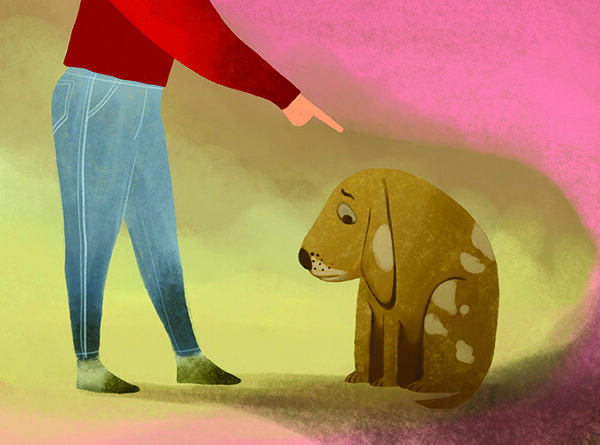Punishment vs. Interruption: Properly Managing Your Dog’s Behavior

“No! Get off the table!” “No! Give that here!” “No! Quit pestering her or I’ll spray you!”
All my life I’ve been around people who tell their dogs, “No!” – and I’ve done it plenty myself. I thought it was punishment. But was it? Punishment is a puzzlement:
■ The word has varied and contradictory definitions.
■ People who think they are punishing their dogs often aren’t doing so. They are merely interrupting the current behavior.
■ We humans have a strong urge to respond in a punitive way to perceived wrongs. It likely comes from having a fast-moving, intuitive brain process. We are wired for retribution!
All this can combine to get us confused and stuck in unproductive behavior patterns with our dogs. But before we can do anything about this, we need to understand and agree on some definitions.
THE DIFFERING DEFINITIONS OF PUNISHMENT
The term “punishment” is defined differently in common usage and in behavior science. This causes many problems of communication and understanding.
Two dictionary definitions of the traditional (common) meaning of punishment are:
• The infliction or imposition of a penalty as retribution for an offense.
• Suffering, pain, or loss that serves as retribution.
These indicate that punishment is an action taken against someone who has committed some type of offense. In this sense of punishment, there is no mention of rehabilitation, and more importantly, no reference to future behavior. Punishment is simply the intentionally unpleasant action the punisher takes against the offender.
Now contrast this with the definition in behavior science. Miltenberger (2008) lists three parts to the definition of punishment:
1. A particular behavior occurs.
2. A consequence immediately follows the behavior.
3. As a result, the behavior is less likely to occur again in the future. (The behavior is weakened.)
Parts 1 and 2 are related to the common definition of punishment, or it seems like they are. But Part 3 is different and particularly hard to keep in mind because of the traditional meaning.
In behavior science, punishment has only occurred if the targeted behavior decreases in the future. That means that at the instant of taking action (Part 2 above), we can’t know whether a behavior has been punished or not. We will only know by observing the animal’s behavior over time.
Making things even more complex, there are two types of punishment defined in behavior science.
• Negative punishment: Something desirable is removed after a behavior, which results in the behavior happening less often.
• Positive punishment: Something aversive is added after a behavior, which results in the behavior happening less often.
Both punishment processes are aversive, and they both carry risks of side effects. But the use of negative punishment is acceptable to some positive reinforcement-based trainers. An example is closing your hand around a treat if the dog tries to grab it when you are trying to teach him to “leave it.”
“Positive punishment” is the process more people feel familiar with. An example is jerking on the leash when a dog pulls ahead, with the intent of decreasing pulling in the future. This type of punishment, which involves the use of an aversive stimulus, carries a great risk of fallout. Positive reinforcement-based trainers seek not to use it.
This is the type of punishment I’ll be discussing in rest of this article.
RETRIBUTION BUT NO BEHAVIORAL DECREASE
It’s common to hear beleaguered dog owners say things like, “I tell my dog ‘NO’ and shake him by the scruff but he keeps jumping on my guests!”
A person who says things like this is trying to punish her dog. She is likely not cruel and she likely loves her dog. But she is following the mores of our culture rather than the science of behavior. She is taking immediate retributive action when the dog does something “bad.”
But what she isn’t doing is reducing the dog’s jumping in the future – the dog might even respond to the scruff shake as an invitation to play! Her actions don’t qualify as “punishment” in the behavioral sense if the dog keeps on jumping.
What such action often achieves is interruption. If you yell at your dog when he barks at the mail carrier, you may interrupt his barking. This is reinforcing . . . to you! “Whew! He stopped barking!” But the next day, he’s at it again! So even though what you want is for your dog never to bark at the mail carrier, what you get is a cycle of bark/yell/relief.
It’s difficult to realize that such actions are not effective in the long term. Stopping the annoyance reinforces us in the short term. And it’s easy to confuse the interruption with training since we are changing the dog’s behavior in the moment.
RETRIBUTION FEELS GOOD
Let’s talk about that urge to take action against another being.
Psychologists who support the dual process theory (Evans, 2009) state that there are two typical human cognitive processes.
“According to dual-process theories, there are two distinct systems underlying human reasoning: an evolutionarily old system that is associative, automatic, unconscious, parallel, and fast; and a more recent, distinctively human system that is rule-based, controlled, conscious, serial, and slow.”
Nobel Prize winner Daniel Kahneman popularized dual process theory in his book Thinking Fast and Slow (2011). He refers to the “fast” system as System 1 and the slower, more thoughtful system as System 2.
There is a lot of research showing that System 1 – the knee-jerk system – governs retributive punishment.
John M. Darley, an American social psychologist and professor of psychology and public affairs at Princeton University, writes:
“When a person registers a transgression against self or others, the person experiences an intuitively produced, emotionally tinged reaction of moral outrage. The reaction is driven by the just deserts-based retributive reactions of the person to the transgression rather than, for instance, considerations of the deterrent force of the punishment…. I suggest that these desires to punish are often the product of intuitive rather than reasoned processes.”
Is this sounding familiar?
If a similar internal process occurs in humans when a dog “misbehaves,” it could explain why retributive punishment can feel so necessary in that situation. (And not just to the owner; ask anyone whose dog has “misbehaved” in public how many people pressured her to do something about it!) Our outraged moral sense misfires on a creature who does not have the same cognition or morals as we do.
But whether or not our urge to punish dogs is linked to the phenomenon Darley and many other scientists have studied, we know that stopping a behavior that is bothering us is reinforcing (to us). Even if there is no future decrease of the annoying behavior, we’ve figured out how to relieve ourselves in the short term. We end up doing it again and again.
It can be devilishly hard to change the pattern of repeatedly yelling, jerking, or hitting dogs, even if we don’t want to hurt or scare them – and I believe most of us don’t. If the phenomenon Darley describes is involved, we are likely wrestling with an old and strong part of the brain when we try to break the habit.
WHY DOESN’T THE YELLING WORK?
We think we understand “positive punishment” because the action of doing something unpleasant to stop a behavior comes naturally to us humans. But it turns out that it’s not that easy to use an aversive stimulus to reduce future behavior, even when that’s the explicit intent.
To begin with, you need to go big. You have to do something that really hurts or scares the dog, not just something unpleasant. (Dogs, like humans, will tolerate an aversive stimulus if there is strong competing reinforcement for the behavior.) Here’s the catch: If you achieve enough intensity to decrease behavior, you risk installing long-term fear in your dog.
There are several other criteria to meet before the dog’s “bad” behavior will decrease through this process. Consistency and timing of the aversive stimulus are crucial. Also, the stimulus must be disassociated from the human if the goal is to suppress the behavior generally. In other words, the dog needs to learn that something bad happens when he tries to get in the trash even when the human isn’t there. Those who haven’t studied behavior science don’t have the information to plan this out. And it takes a System 2 response, rather than the knee-jerk, System 1 response, to make that plan. I’m not condoning punishment, planned or unplanned; I’m just saying that often when people think they are punishing behavior, they aren’t.
So we could repeatedly “punish” a dog in the cultural sense of the word without achieving punishment in the behavior science sense. Even though we might get temporary relief from doing it, the cycle is not fun for the human. Who wants to yell at their dog or spray them with water or threaten them all the time? And for the dog, this cycle can be anywhere from annoying to terrifying.
So what Does Work?
Effective positive punishment is much harsher than we would ever want to be with our dogs. Unpleasant interruption does little about future behavior. So what are we left with?
There is a straightforward, humane way to interrupt behavior in real life while also creating a long-term plan for behavior change. A well-trained and practiced “positive interrupter” can stop dangerous or undesirable behavior in its tracks. It’s an attention/reorientation cue trained with positive reinforcement. And if the interrupter is combined with a plan to remove opportunities for the undesired behavior, the unwanted behavior will decrease.
Note that “positive interrupter” is not a term from behavior science; it’s just a cue that is trained with positive reinforcement. But some people train a special cue for this rather than calling the dog away with their recall or “leave it” cue.
I trained a special positive interrupter with two of my dogs whose play was intense. Even though they never hurt each other during play, they would ramp up, and I felt like the possibility of aggression was always there.
I used the phrase “Cool it!” given in a pleasant, sing-song voice. I worked with each dog separately at first. I trained it just like I would train any cue to reorient to me: I paired the phrase with treats. I started in a super-easy environment, teaching them that the words predicted something yummy. Then I started using it in easy real-life situations, for instance, if they were in the same room with me but paying attention to something else, or if they were one room away but looking my way. They would need to reorient or come to me to get the goodie.
When I started using it in play, I used it during periods where they were having a breather, then worked up to interrupting full-intensity play. It worked beautifully and had the overall effect that they learned they could interrupt themselves when things got intense.
I was learning, too. It can be counterintuitive to say something pleasant to your dogs and give them a treat when you are worried and want to yell, “Stop it!” The process helped me escape that System 1, knee-jerk response, and do something that was win-win instead.
It’s best to use an interrupter in an environment where the dog has plenty of ways to access reinforcers, such as getting on a mat, sitting nicely, or playing training games. In an environment where there are easier ways to earn reinforcers, the undesired behavior will likely fade over time instead of increasing. Also, in a richly reinforcing environment, there is less chance of the dog learning the pattern of “Be naughty so I can get called away and get reinforced.”
Positive interruption is a better method than both actual punishment, with its unpleasantness, fallout, and endless cycle. And calling such a cue an interrupter can help people who are new to behavior science have a special name for an action that they want very much – a way to get their dog to stop doing that!
This article was first published in Clean Run – The Magazine for Dog Agility Enthusiasts.
Dog trainer Eileen Anderson writes about behavior science, her life with dogs, and training with positive reinforcement on her blog (eileenanddogs.com). She is also the author of Remember Me? Loving and Caring for a Dog with Canine Cognitive Dysfunction. See page 24 for information.
References
Darley, J. M. (2009). “Morality in the law: The psychological foundations of citizens’ desires to punish transgressions.” Annual Review of Law and Social Science, 5, 1-23.
Evans, J. S. B., & Frankish, K. E. (2009). In Two Minds: Dual Processes and Beyond. Oxford University Press.
Kahneman, D., & Egan, P. (2011). Thinking, Fast and Slow. New York: Farrar, Straus and Giroux.
Miltenberger, R. G. (2008). Behavior modification: Principles and procedures. Wadsworth, Cengage Learning.





